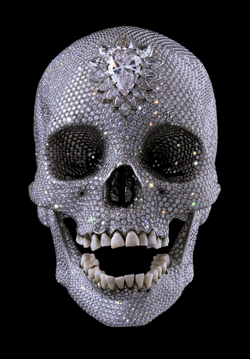For the Love of God

While Damien Hirst’s exhibition ‘Beyond Belief’ filled both White Cube’s Hoxton Square and Mason’s Yard sites, in truth it turned on a single work, hived away in a heavily guarded black box. This, as any newspaper reader will be aware, was For the Love of God (2007), a platinum cast of the skull of an unknown 18th-century European, encrusted with 8,601 pavé set diamonds. To parse a jewel, though, one must also parse its setting, the ring in which it is bound. In the case of ‘Beyond Belief’ this was a system of objects and images that strayed only a millimetre or two from the works with which Hirst first made his name.
Accordingly, there were butterfly paintings and cabinets full of marine specimens, several (awful) canvases of cancer cells flecked with scalpel blades and broken glass, and a number of animal corpses suspended in their customary tanks of amniotic formaldehyde. At Mason’s Yard the bisected shark of Death Explained (2007) revisited Hirst’s own celebrated The Physical Impossibility in the Mind of Death in the Mind of Someone Living (1991), whereas at Hoxton Square his bound and arrow-stuck bullock Saint Sebastian, Exquisite Pain (2007) borrowed its art-historical ballast from Antonio del Pollaiuolo’s painting The Martyrdom of Saint Sebastian (1475). Also in Hoxton, The Adoration (2007) was a nativity scene played out in a spotless glass vitrine, with a silver foetus’ skeleton standing in for the infant Jesus and flayed sheep corpses for the worshipful shepherds. Oddly, the three small tanks that contained the sheep were topped with children’s toys, whose shapes conformed to those that Paul Cézanne considered to be the building blocks of nature: the cylinder, the sphere and the cone. Maybe Hirst is making a joke about theology versus art theory, or mystical versus optical vision, but if so it’s a little clumsy and was anyway lost in the noisome buzz of art-historical references – the Minimalist cube, Jeff Koons’ bobbing basketballs, the paintings of Francis Bacon, Chaim Soutine and numerous Renaissance Masters – that emanated from the work. These are well-worn touchstones in Hirst’s art, but he does not wrestle with them as he once did but rather simply appropriates their cultural weight. Similarly, for all the supposed timelessness of the themes that wind through the artist’s practice, it’s been years since he made a really affecting statement on laughter, hope and death. His once strange voice has become familiar, and this has bred, if not contempt, then a kind of filial certainty that he’ll do nothing to surprise.
And yet, for all that the works displayed in the main gallery spaces felt like an incremental cheapening of Hirst’s legacy, these were little more than a side-show to ‘Beyond Belief’s vivid main event. The experience of viewing For the Love of God was a meticulously choreographed affair, with holders of timed tickets being escorted into a dark room by muscular security guards, there to spend two minutes staring into its spot-lit, empty eyes before being ushered out into the street. Two minutes, 8,601 gemstones, the well-publicized £15 million production costs and a £50 million price tag – this work was about nothing if not numbers (indeed, any buyer who broke down For the Love of God into its raw materials for resale would see £35 million worth of pure ‘art’ disappear into the ether). But while such sums contribute much to the work’s charge, they do not, surprisingly, upstage its physical presence. Applied to almost every inch of the piece (the teeth are real, and the septum is a cocaine-vulnerable sliver of uncovered platinum), the diamonds resemble a honeycomb fit for the queenliest of bees, or a moon gleaming in some other, better heaven. Not some tyrant’s obscene trinket, then, but rather something that for all its brilliant mineral hardness also speaks of the slow compacting of carbon atoms, of stickiness and flow. The publicity material doesn’t state the gender of the skull from which the work was cast, but it’s hard not to think of it as a goddess, laughing at Man’s fripperies, his blink-long concept of time.
Significantly, a large, pear-shaped diamond sits atop the skull’s forehead – a third eye, crown chakra or some other point of contact with the divine. If traditional memento mori are about accepting the universal fact of death, Hirst’s skull is about leaving a beautiful corpse that, with its ineffable durability, will witness the end of time. When God’s last breath blows across the ashes of the world, this terrible object will remain. This is terminal art. Art for when all our futures run out.
















